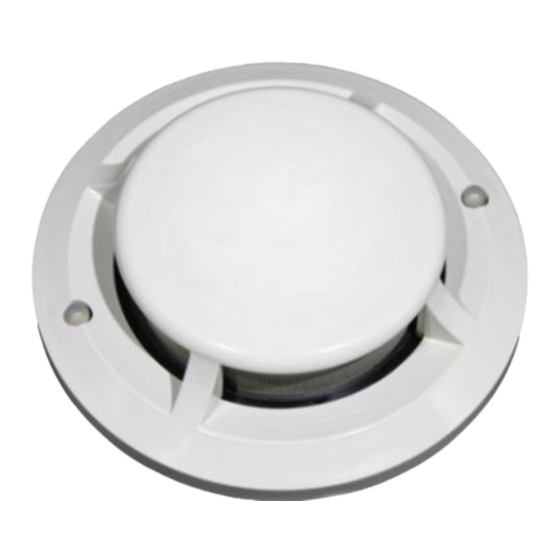Advertisement
Quick Links
INSTALLATION AND MAINTENANCE INSTRUCTIONS
2251 Intelligent Photoelectronic
Smoke Sensor
Specifications
Operating Voltage Range:
Max. Avg. Standby Current:
Max. Alarm Current (LED on:)
Operating Humidity Range:
Operating Temperature Range:
Height:
Diameter:
Weight:
Before Installing
This sensor must be installed in compliance with the con-
trol panel system installation manual. The installation
must meet the requirements of the Authority Having Juris-
diction (AHJ). Sensors offer maximum performance when
installed in compliance with the National Fire Protection
Association (NFPA); see NFPA 72.
General Description
Model 2251 is a plug-in type smoke sensor that combines a
photoelectronic sensing chamber with addressable-analog
communications. The sensor transmits an analog represen-
tation of smoke density over a communication line to a
control panel. Rotary-decade switches are provided for set-
ting the sensor's address. Two LEDs on the sensor are con-
trolled by the panel to indicate sensor status. An output is
provided for connection to an optional remote LED annun-
ciator (P/N RA400Z).
The 2251 requires compatible addressable communica-
tions to function properly. Connect this sensor to listed-
compatible control panels only.
D200-03-00
15 to 32 VDC
330µA @ 24 VDC (one communication every 5 sec. with LED blink enabled)
6.5 mA @ 24 VDC
10% to 93% Relative Humidity, noncondensing
0° to 49°C (32° to 120°F)
1.7 inches (43 mm) installed in B210LP Base
6.2 inches (155 mm) installed in B210LP Base
4.1 inches (104 mm) installed in B501 Base
3.6 oz. (102 g)
1
3825 Ohio Avenue, St. Charles, Illinois 60174
Spacing
System Sensor recommends spacing sensors in compliance
with NFPA 72. In low air flow applications with smooth
ceilings, space sensors 30 feet apart. For specific informa-
tion regarding sensor spacing, placement, and special ap-
plications, refer to NFPA 72 or the System Sensor Guide For
Proper Use of System Smoke Detectors, available at no
charge from System Sensor (P/N I56-407-XX).
Wiring Instructions
All wiring must be installed in compliance with the Na-
tional Electrical Code, applicable local codes, and any spe-
cial requirements of the Authority Having Jurisdiction.
Proper wire gauges should be used. The installation wires
should be color-coded to limit wiring mistakes and ease
system troubleshooting. Improper connections will prevent
a system from responding properly in the event of a fire.
Remove power from the communication line before in-
stalling sensors.
All wiring must conform to applicable local codes, ordi-
nances, and regulations.
1. Wire the sensor base (supplied separately) per the wir-
ing diagram, see Figure 1.
2. Set the desired address on the sensor address switches,
see Figure 2.
3. Install the sensor in to the sensor base. Push the sensor
into the base while turning it clockwise to secure it in
place.
4. After all sensors have been installed, apply power to the
control unit and activate the communication line.
5. Test the sensor(s) as described in the TESTING section
of this manual.
A Division of Pittway
1-800-SENSOR2, FAX: 630-377-6495
I56-582-04
Advertisement

Summary of Contents for System Sensor 2251
- Page 1 Proper Use of System Smoke Detectors, available at no charge from System Sensor (P/N I56-407-XX). General Description Model 2251 is a plug-in type smoke sensor that combines a Wiring Instructions photoelectronic sensing chamber with addressable-analog All wiring must be installed in compliance with the Na- communications.
- Page 2 Figure 1. Wiring diagram: A78-2461-00 mentation for sensor LED status operation and ex- pected delay to alarm. Dust covers provide limited protection against airborne B. Sensitivity: Test Module (MOD400R) dust particles during shipping. Dust covers must be re- A sensitivity test module socket is provided for checking moved before the sensors can sense smoke.
- Page 3 Figure 2. Rotary decade address switches: Cleaning It is recommended that the detector be removed from its mounting base to facilitate cleaning. The detector is cleaned as follows: NOTE: Before removing the detector, notify the proper au- thorities that the smoke detector system is under- going maintenance and will be temporarily out of service.
- Page 4 NFPA 72 or at least once a year. Three-Year Limited Warranty System Sensor warrants its enclosed smoke detector to be free from de- ment, RA #__________, 3825 Ohio Avenue, St. Charles, IL 60174. Please fects in materials and workmanship under normal use and service for a include a note describing the malfunction and suspected cause of failure.






Need help?
Do you have a question about the 2251 and is the answer not in the manual?
Questions and answers